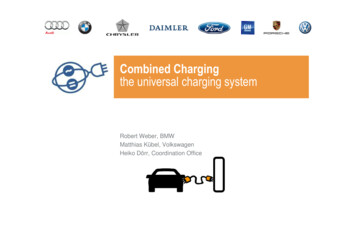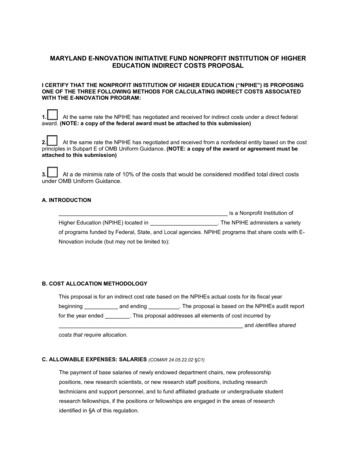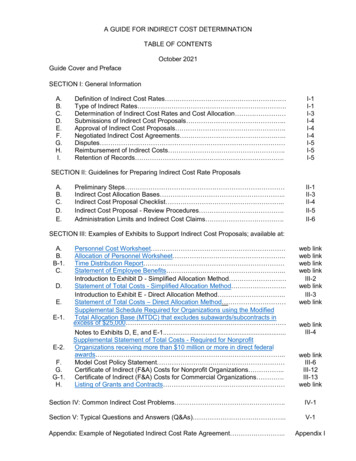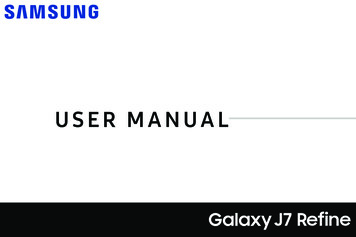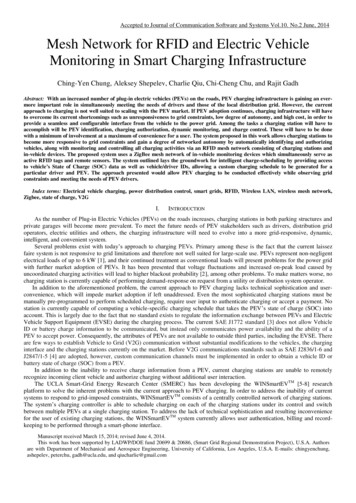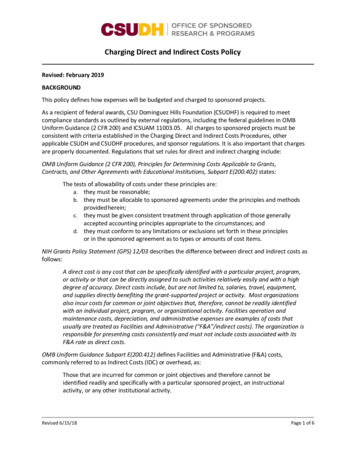
Transcription
Charging Direct and Indirect Costs PolicyRevised: February 2019BACKGROUNDThis policy defines how expenses will be budgeted and charged to sponsored projects.As a recipient of federal awards, CSU Dominguez Hills Foundation (CSUDHF) is required to meetcompliance standards as outlined by external regulations, including the federal guidelines in OMBUniform Guidance (2 CFR 200) and ICSUAM 11003.05. All charges to sponsored projects must beconsistent with criteria established in the Charging Direct and Indirect Costs Procedures, otherapplicable CSUDH and CSUDHF procedures, and sponsor regulations. It is also important that chargesare properly documented. Regulations that set rules for direct and indirect charging include:OMB Uniform Guidance (2 CFR 200), Principles for Determining Costs Applicable to Grants,Contracts, and Other Agreements with Educational Institutions, Subpart E(200.402) states:The tests of allowability of costs under these principles are:a. they must be reasonable;b. they must be allocable to sponsored agreements under the principles and methodsprovided herein;c. they must be given consistent treatment through application of those generallyaccepted accounting principles appropriate to the circumstances; andd. they must conform to any limitations or exclusions set forth in these principlesor in the sponsored agreement as to types or amounts of cost items.NIH Grants Policy Statement (GPS) 12/03 describes the difference between direct and indirect costs asfollows:A direct cost is any cost that can be specifically identified with a particular project, program,or activity or that can be directly assigned to such activities relatively easily and with a highdegree of accuracy. Direct costs include, but are not limited to, salaries, travel, equipment,and supplies directly benefiting the grant-supported project or activity. Most organizationsalso incur costs for common or joint objectives that, therefore, cannot be readily identifiedwith an individual project, program, or organizational activity. Facilities operation andmaintenance costs, depreciation, and administrative expenses are examples of costs thatusually are treated as Facilities and Administrative (“F&A”/indirect costs). The organization isresponsible for presenting costs consistently and must not include costs associated with itsF&A rate as direct costs.OMB Uniform Guidance Subpart E(200.412) defines Facilities and Administrative (F&A) costs,commonly referred to as Indirect Costs (IDC) or overhead, as:Those that are incurred for common or joint objectives and therefore cannot beidentified readily and specifically with a particular sponsored project, an instructionalactivity, or any other institutional activity.Revised 6/15/18Page 1 of 6
All costs charged to a sponsored project must comply with any terms and conditions or restrictionsof the Notice of Grant Award (NGA) or other award/contract documentation.BUDGET ITEMS TYPICALLY CHARGED AS DIRECT COSTSPersonnel Expenses1. Salaries, Wages and Fringe Benefitsa. Salaries, wages, and fringe benefits for non-administrative personnel (PrincipalInvestigators, co-investigators, research staff, etc.) are allowable as direct chargeson sponsored projects when the charges reflect actual work performed and directlybenefit the sponsored project.b. Salaries, wages, and fringe benefits for administrative personnel are typicallyunallowable direct charges on a sponsored project. However, there are exceptionswhen these costs may be charged directly to a sponsored project (i.e., a grantproposal requests, and the sponsor approves, funds for administrative support for amajor program.c. Salary, wage, and fringe benefit charges must be consistent with all other applicableCSUDH Foundation hiring procedures and employment practices, including notworking prior to completing the hiring process.d. Costs associated with providing fringe benefits (FICA, health insurance, retirement,workers’ compensation insurance, state unemployment tax, etc.) to grant-fundedpersonnel are charged on an actual basis to the sponsored project.2. Independent Contractors/Special Consultantsa. Even if approved in the awarded budget, the Independent Contractor/SpecialConsultant must meet CSUDH Foundation’s hiring criteria. CSUDH Foundation’sHuman Resources will make the determination as to whether an independentcontractor meets the necessary requirements and can be hired.Non-Personnel Expenses Subject to IDC/F&A Rates1. Suppliesa. Supplies directly related to the project, such as technical or scientific supplies, areallowable if they are purchased to directly benefit the project.b. Office supplies are only allowable as direct charges to a sponsored project if theyare necessary to complete the project and they are used solely for the project.Otherwise, general office supplies are typically unallowable as direct charges, andare instead covered by the University’s F&A rate.2. Travela. Travel costs, including transportation, lodging, and per diem rates are allowable.These expenditures must meet CSUDH Foundation/CSU Travel Policies andProcedures.b. Additional travel guidelines or regulations listed in the Notice of Grant Award mustbe followed. Sponsor guidelines supersede CSUDH Foundation guidelines in thesecases.3. Meals and Entertainmenta. CSUDH hospitality policy regarding meals and entertainment expenses apply toRevised 6/15/18Page 2 of 6
all sponsored projects.b. Many sponsors have more specific regulations than CSUDH. Sponsor guidelinessupersede CSUDH guidelines in these cases.c. The following items are generally not allowable as Meal and Entertainment expenseson sponsored projects:i. Alcoholii. Magazines/Newspapersiii. Moviesiv. Flowersv. Gifts and Souvenirsvi. Concerts/Eventsvii. Balloonsviii. Spa Treatments4. Animal Carea. Animal care costs included in the awarded budget are allowable direct chargesto a sponsored project, as defined by the sponsor guidelines.b. If animal care costs exceed the budgeted amount or were not included in the awardedbudget, refer to the sponsor guidelines regarding the allowability of these costs.5. Equipmenta. Capital Equipment is defined as items with an acquisition cost of 5,000 or more,and may also include consolidated equipment with a total value of 5,000 ormore. Typically, capitalized equipment that meets this definition is waived fromindirect costs, based on CSUDH’s federally negotiated F&A rate agreement.b. Equipment that is used specifically for the benefit of a sponsored project may becharged directly to the sponsored project, depending on the sponsor’s guidelines.6. Subcontracts/Subawards (Consortium/Contractual Costs)a. Subcontract/subaward agreements specified in the awarded budget are allowabledirect charges to a sponsored project. If a subcontract/subaward is not in the awardedbudget, refer to the sponsor for their specific requirements.b. Only the first 25,000 of a given subcontract/subaward agreement is subject to indirectcosts.Non-Personnel Expenses Exempt from IDC/F&A Rates1. Participant Support Costsa. Per sponsor guidelines, Participant Support Costs are allowable Direct Chargesto a sponsored project.2. Stipendsa. Stipend costs are allowable direct charges to a project at the rate defined in theapproved budget and within sponsor guidelines.3. Tuitiona. Student tuition costs are allowable direct charges to a project at the rate defined inthe approved budget and within sponsor guidelines. Tuition costs are exempt fromF&A Costs.Revised 6/15/18Page 3 of 6
INDIRECT COSTS OR FACILITIES AND ADMINISTRATIVE COSTSExamples of F&A Costs UtilitiesSalaries, wages, and fringe benefits for clerical and administrative staffGeneral purpose laptop computers and other highly desirable personal electronicdevices that cannot be identified readily and specifically with a particular sponsoredproject, an instructional activity, or any other institutional activity (e.g., iPads)Office supplies (basic supplies)SubscriptionsLibrary booksPeriodicalsMembershipsOffice and general purpose equipment (office furniture, general purpose lab equipment, etc.)PhotocopyingPostageRepair and maintenance (e.g,. equipment)Telephone/cell phone, internet costs (e.g., monthly bills)Proposal development costsExceptions: Charging F&A-Type Costs as Direct CostsJustification for these types of charges must be well documented by the person incurring the cost. Someexamples of projects in which the direct charging of costs normally considered F&A costs is appropriateinclude:1. Large, complex programs, such as research centers, institutes, and other sponsoredagreements that entail assembling and managing teams of investigators (e.g., as definedby 2 CFR 200.413 Subpart E).2. Projects that require preparation and production of manuals, large reports, or surveysto meet the objectives of a specific sponsored project.3. Projects designated as “off-campus” that are charged the off-campus F&A Cost rate. Forexample, rent and utilities may be directly charged to off-campus projects.Specific Examples of Exceptions Postage/Photocopies: Allowable if a direct benefit to the project can be documented (e.g.,if a survey is being conducted as part of a project, copying and postage are allowabledirect charges).Office Supplies: Allowable if it can be documented that there is a need for a greateramount of supplies for a project than is typically available (e.g., external mediastorage devices to store data).Meetings and Conferences: Costs of meetings and conferences are allowable if they arespecifically provided for in the awarded budget, and the activity directly benefits theproject. Items such as flowers, balloons, gifts, etc. are unallowable.Telecommunications: Telecommunications costs associated with a specific sponsoredproject can be direct charged (e.g., long distance charges can be direct charged to asponsored project if the call benefits the project directly), but the appropriateness ofthese charges must be documented in all instances. If a telephone has been installed forRevised 6/15/18Page 4 of 6
the sole use of a particular sponsored program activity (e.g., conducting a phone survey isan objective of the project) and will be removed when the project terminates, therelated monthly service, voicemail, and non-toll expenses can be charged to thesponsored project. Cell phones, internet service, smart phones, and home internetservice provider charges are only allowable if explicit approval from the sponsor isreceived, programmatic necessity can be documented, and the services are usedexclusively for the sponsored project(s). No other telecommunication expenses shouldbe direct charged as to a sponsored project.Determining Allowable and Unallowable Costs Allowable costs must meet the terms and conditions of the award and a test ofreasonableness.Purchasing items to “spend down” available funds is prohibited by federal regulation. Allcosts charged to a project must specifically benefit the project they are charged.Large purchases made towards the end of a budget period, where it is not reasonable toexpect the product(s) purchased can be used by the end date of the project, areunallowable (e.g. a large amount of general lab supplies purchased during the last week ofan award).It is the responsibility of each Principal Investigator (PI) to monitor the award budget andensure purchases are made in a timely manner.UNACCEPTABLE DIRECT CHARGING PRACTICESInappropriate Practices for Charging Direct Costs to Sponsored Projects Shifting costs to other sponsored projects in order to meet budget or funding deficiencies.Shifting costs to other sponsored projects to avoid sponsor restrictions.Assigning costs to projects in order to quickly spend down a remaining balance, such as:o Charging large equipment expenditures at the end of a project.o Increasing salary expenses on a project that are not consistent with actual effortexpended.Charging costs incurred for multiple projects or functions to several sponsored projectswhen there is difficulty determining the relative benefit of the cost to each sponsoredproject (see Charging Costs to Multiple Projects below).Charging an expense exclusively to one award when the expense was used to supportother activities (see Charging Costs to Multiple Projects below).Rotating charges among projects without establishing that the rotation schedule accuratelyreflects the relative benefit to each project during that specified period.Charging only the budgeted amount (in contrast to charging actual costs).Assigning charges to an award before the cost is incurred.Assigning personnel charges that are part of the normal administrative support forawards (proposal preparation, accounting, payroll, etc.).Charging Costs to Multiple Projects1. Some direct costs benefit multiple projects. Examples include copying, publishing costs,bulk lab supplies, and office supplies. These costs should be allocated to projects inproportion to the benefit. The NIH Grants Policy Statement states:Revised 6/15/18Page 5 of 6
When salaries or other activities are supported by two or more sources, issues arise asto how the direct costs should be allocated among the sources of support. In general, acost that benefits two or more projects or activities in proportions that can bedetermined without undue effort or cost should be allocated to the projects based onthe proportional benefit. A cost that benefits two or more projects or activities inproportions that cannot be determined because of the interrelationship of the workinvolved may be allocated or transferred to the benefiting projects on any reasonablebasis.2. The method for allocating direct costs to multiple projects must be identified in advanceof the allocation, and must be documented. Documentation to split costs for purchaserequisitions should be included in departmental records. Documentation for allocation ofspecial check requests through accounts payable should be documented in the commentssections of the request. The allocation method must be consistently applied to allsponsored projects in a defined group (e.g., department, PI, etc.). Switching betweenmethods for convenience is not acceptable.3. The following are charges that may be allocated to multiple projects:a. Lab personnel working on each project, as certified on their Time and Effort Reportsb. Number of activities performed (e.g., project A has 20 experiments and project Bhas 40 experiments, therefore 1/3 of the costs will be allocated to project A and2/3 to project B)c. Rates established by a service center or other lab that correlates to the cost beingallocated (e.g., animal facility charges)4. Cost methods should not be allocated to multiple projects based on:a. Budget over-expendituresb. Expending remaining unspent fundsc. Rotating costs between projectsd. Pro-rated square footageIndirect Costs or Facilities and Administrative (F&A) RateCSUDH will not “waive” (accept a lower amount than the federally negotiated rate) F&A unless requiredby the sponsor. The lower rate must be in writing in a publicly viewable document. F&A costs are paid asa percent of direct expenditures. Approximately every five years, CSUDH negotiates an F&A costagreement with their cognizant government agency (Department of Health and Human Services). TheCSUDH F&A cost rate states the rate of F&A costs that the government will reimburse to CSUDH relatedto activities on a sponsored program.Federal: The CSUDH F&A cost rate should be used except for those programs that publish a lower rate.Additionally, depending on where the sponsored activity will take place (on-campus or off-campus) orthe type of activity (basic research, instruction, or other sponsored activities), different rates may apply.Non-Federal: Many non-federal sponsors, such as foundations, limit the F&A rate they will pay. In thesecases, it is CSUDH procedure to charge the maximum amount allowed by the sponsor, based on thesponsor’s published rates.Subcontracts/Subawards: It is important to determine the original source of funding on any incoming oroutgoing subaward/subcontract agreement. Based on this determination, the appropriate criteria listedabove should be used to determine the F&A rate.Revised 6/15/18Page 6 of 6
Revised 6/15/18 Page 4 of 6 INDIRECT COSTS OR FACILITIES AND ADMINISTRATIVE COSTS Examples of F&A Costs Utilities Salaries, wages, and fringe benefits for clerical and administrativestaff General purpose laptop computers and other highly desirable personal electronic devices that cannot be identified readily and specifically with a particular sponsored

